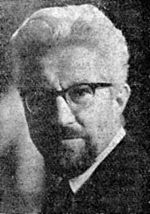Carl Troll facts for kids
Quick facts for kids
Carl Troll
|
|
|---|---|
 |
|
| Born | 24 December 1899 Gabersee, German Empire
|
| Died | 21 July 1975 (aged 75) |
| Nationality | German |
| Citizenship | Germany, West Germany |
| Alma mater | University of Munich |
| Awards | Vega Medal (1951) Victoria Medal (1962) Albrecht-Penck-Medaille (1964) |
| Scientific career | |
| Fields | Climatology Geography Landscape ecology |
Carl Troll (born December 24, 1899, died July 21, 1975) was an important German geographer. He was the brother of botanist Wilhelm Troll. Carl Troll was very interested in how the environment and living things interact, especially in mountains.
From 1919 to 1922, Carl Troll studied many subjects at the University of Munich. These included biology, chemistry, geology, geography, and physics. He earned his doctorate in botany in 1921. Later, in 1925, he completed his habilitation in geography, which allowed him to teach at a university.
Between 1922 and 1927, he worked as an assistant at the Geography Institute in Munich. Carl Troll loved to travel and research. From 1926 to 1929, he went on a big research trip across the Andes mountains in South America. He visited countries like Chile, Bolivia, Peru, Ecuador, Colombia, and Panama. His travels also took him to East and South Africa in 1933 and 1934. In 1937, he was in Ethiopia, and in 1954, he visited Mexico.
In 1930, Carl Troll became a professor in Berlin. In 1938, he became a geography professor in Bonn. He was a pioneer in using aerial photographs for his research. In 1939, he created the term "Landscape ecology". This field studies how different parts of a landscape, like plants, animals, and landforms, interact with each other. He also created special maps and ways to classify climates based on water, living things, and economic information.
Carl Troll was also the president of the International Geographical Union from 1960 to 1964.
Exploring the Andes Mountains
Carl Troll's work in the Andes mountains was very special. Unlike some other scientists of his time, he didn't think that Western science was always better. He also didn't believe that societies had to develop in a certain way.
One of the most famous parts of his Andean research is about "vertical zonation." This means how different plants and animals live at different heights on a mountain. He built on the ideas of another famous scientist, Alexander von Humboldt.
The Inca Empire and Its Environment
Carl Troll believed that the environment helped the Inca state grow in the central Andes. He thought that conditions there were perfect for making a special food called chuño. Chuño is made from potatoes dried at freezing temperatures, which are common at night in the southern Peruvian highlands. This dried potato could be stored for a long time, which was very important for feeding a large empire.
However, some people disagree. They point out that other crops, like corn, could also be dried just by the sun. Troll also noted that llamas, which the Incas used as pack animals, were found in large numbers in the same region. It's interesting that the largest area where alpacas and llamas lived before Europeans arrived matched the size of the Inca Empire.
The connection between the Andean environments (like the puna and páramo biomes), raising animals, and the Inca state is still being studied. Troll also thought that the Incas' irrigation technology helped their state grow. Even though he saw how the environment influenced the Inca Empire, Carl Troll did not believe in "environmental determinism." This idea says that the environment completely controls how cultures develop. Instead, he argued that culture was the most important part of the Inca civilization.
Images for kids
See also
 In Spanish: Carl Troll para niños
In Spanish: Carl Troll para niños


